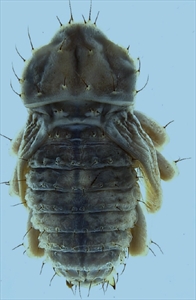Ginger weevil, Fiji lemon weevil.
Pacific Pests, Pathogens, Weeds & Pesticides - Online edition
Pacific Pests, Pathogens, Weeds & Pesticides
Ginger weevil (357)
Elytroteinus geophilus; previously, Elytroteinus subtruncatus.
Southeast Asia, North America (Hawaii), Oceania. It is recorded from American Samoa, Cook Islands, Fiji, French Polynesia, New Zealand, Samoa.
Ginger rhizomes, coconut, chillies, eggplant, kava, lemon, orchids, roselle (Hibiscus sabdariffa), Strelitzia (bird-of-paradise) tubers, sugarcane, sweetpotato storage roots, taro and Alocasia corms, ti (Cordyline terminalis), and yam tubers. It is also found in stems of passionfruit in Samoa (see Fact Sheet no. 155).
The larvae or grubs do the damage by burrowing into roots, stems, and storage organs of a wide range of crops of economic importance (Photo 1). Damage to stems results in wilt or plants that are unthrifty.
The life cycle is not well known. Eggs are laid in the storage organs and stems and hatch to produce legless creamy-white larvae with brown heads, about 12 mm long when mature (Photos 2&3). The larvae have abdominal segments with three folds. Pupation within the storage organs or stems, leads to adults, 5-8 mm long, brown, with faint white patches in the centre of the wing cases, somewhat 'W'-shaped (Photos 4-7).
In the case of passion fruit collar rot (see Fact sheet no. 155), the eggs are laid in the stem at the collar region. They hatch after a few days, produce larvae that moult 5-6 times and then pupate. One to two weeks later, adults emerge by making small holes in the stem. Further damage is done by fungi (Lasiodiplodia and Fusarium).
Mostly, the ginger weevil causes low level or moderate damage. Individual plants may be attacked severely but the damage is low overall. An exception is passionfruit in Samoa where basal stem cankers are reported that can infect or kill 50% of plants in 2 years. Damage is worse during the dry season.
The ginger weevil and the West Indian sweet potato weevil are similar, although there are differences in overall size of the larvae, features on the head capsule and the number of folds on the abdominal segments. However, the adults are easier to distinguish: the ginger weevil is covered in fine, semi-erect, but very short scales - without long thin erect scales - and without a clear pattern on the wing cases. Also, the ends of the wing cases are blunt.
The group to which the ginger weevils belongs is called the Cryptorhynchini. Look for the nose that fits into a deep groove or slot between the front legs (Photo 7).
CULTURAL CONTROL
Before planting:
- Make sure that there is no carry over of larvae, pupae or adults in planting material. The most vulnerable crops are ginger, taro and yam, as the planting piece is part or the entire storage organ. Inspect planting material carefully, and remove those that appear infested.
- Note that treatment of ginger rhizomes before planting for the control of Pratylenchus and Radophilus is likely to destroy infestations of ginger weevil. Treatment should be 51°C for 10 minutes.
During growth:
- If cankers develop on passionfruit stems at soil level, treat as detailed under Chemical Control (below).
After harvest:
- Check all storage roots, corms and tubers at harvest and separate any with symptoms of infestation from those that are healthy. Cut out infested parts and destroy by burning; retain healthy parts for household use.
- Do not store ginger or yams with symptoms of infestation.
CHEMICAL CONTROL
In Samoa, the use of a thiram/latex mixture painted onto cankers of passionfruit stems at soil level has been effective. No treatment with insecticide has been reported, but it is likely that dipping planting material in imidacloprid will destroy internal infestations of weevils.
____________________
When using a pesticide, always wear protective clothing and follow the instructions on the product label, such as dosage, timing of application, and pre-harvest interval. Recommendations will vary with the crop and system of cultivation. Expert advice on the most appropriate pesticide to use should always be sought from local agricultural authorities.
AUTHOR Grahame Jackson
Information from Elytroteinus subtruncatus (Fairmaire). Fiji Ginger weevil. Knowledge Master. University of Hawai'i, Manoa. (http://www.extento.hawaii.edu/kbase/crop/type/elytrote.htm); and from Gerlach WWP (1988) Plant diseases of Western Samoa. Samoan German Crop Protection Project, Deutsche Gesellschaft für Technische Zusammenarbeit (GTZ) Gmbh, Germany. Photos 1&5 Mani Mua, SPC, Sigatoka Research Station, Fiji. Photos 2&4 Chris Reid & John Martin, Australian Museum, Sydney. Photos 3,6&7 MAF Plant Health and Environment Laboratory (2010) Fijian Ginger Weevil (Elytroteinus geophilus): PaDIL - (http://www.padil.gov.au).
Produced with support from the Australian Centre for International Agricultural Research under project HORT/2016/185: Responding to emerging pest and disease threats to horticulture in the Pacific islands, implemented by the University of Queensland and the Secretariat of the Pacific Community.










